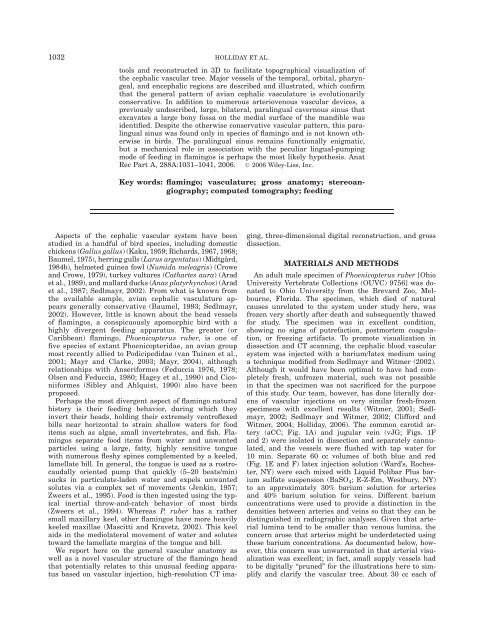Cephalic vascular anatomy in flamingos - Ohio University College of ...
Cephalic vascular anatomy in flamingos - Ohio University College of ...
Cephalic vascular anatomy in flamingos - Ohio University College of ...
Create successful ePaper yourself
Turn your PDF publications into a flip-book with our unique Google optimized e-Paper software.
1032 HOLLIDAY ET AL.<br />
tools and reconstructed <strong>in</strong> 3D to facilitate topographical visualization <strong>of</strong><br />
the cephalic <strong>vascular</strong> tree. Major vessels <strong>of</strong> the temporal, orbital, pharyngeal,<br />
and encephalic regions are described and illustrated, which confirm<br />
that the general pattern <strong>of</strong> avian cephalic vasculature is evolutionarily<br />
conservative. In addition to numerous arteriovenous <strong>vascular</strong> devices, a<br />
previously undescribed, large, bilateral, paral<strong>in</strong>gual cavernous s<strong>in</strong>us that<br />
excavates a large bony fossa on the medial surface <strong>of</strong> the mandible was<br />
identified. Despite the otherwise conservative <strong>vascular</strong> pattern, this paral<strong>in</strong>gual<br />
s<strong>in</strong>us was found only <strong>in</strong> species <strong>of</strong> flam<strong>in</strong>go and is not known otherwise<br />
<strong>in</strong> birds. The paral<strong>in</strong>gual s<strong>in</strong>us rema<strong>in</strong>s functionally enigmatic,<br />
but a mechanical role <strong>in</strong> association with the peculiar l<strong>in</strong>gual-pump<strong>in</strong>g<br />
mode <strong>of</strong> feed<strong>in</strong>g <strong>in</strong> flam<strong>in</strong>gos is perhaps the most likely hypothesis. Anat<br />
Rec Part A, 288A:1031–1041, 2006. Ó 2006 Wiley-Liss, Inc.<br />
Key words: flam<strong>in</strong>go; vasculature; gross <strong>anatomy</strong>; stereoangiography;<br />
computed tomography; feed<strong>in</strong>g<br />
Aspects <strong>of</strong> the cephalic <strong>vascular</strong> system have been<br />
studied <strong>in</strong> a handful <strong>of</strong> bird species, <strong>in</strong>clud<strong>in</strong>g domestic<br />
chickens (Gallus gallus) (Kaku, 1959; Richards, 1967, 1968;<br />
Baumel, 1975), herr<strong>in</strong>g gulls (Larus argentatus) (Midtgård,<br />
1984b), helmeted gu<strong>in</strong>ea fowl (Numida meleagris) (Crowe<br />
and Crowe, 1979), turkey vultures (Cathartes aura) (Arad<br />
et al., 1989), and mallard ducks (Anas platyrhynchos)(Arad<br />
et al., 1987; Sedlmayr, 2002). From what is known from<br />
the available sample, avian cephalic vasculature appears<br />
generally conservative (Baumel, 1993; Sedlmayr,<br />
2002). However, little is known about the head vessels<br />
<strong>of</strong> flam<strong>in</strong>gos, a conspicuously apomorphic bird with a<br />
highly divergent feed<strong>in</strong>g apparatus. The greater (or<br />
Caribbean) flam<strong>in</strong>go, Phoenicopterus ruber, is one <strong>of</strong><br />
five species <strong>of</strong> extant Phoenicopteridae, an avian group<br />
most recently allied to Podicipedidae (van Tu<strong>in</strong>en et al.,<br />
2001; Mayr and Clarke, 2003; Mayr, 2004), although<br />
relationships with Anseriformes (Feduccia 1976, 1978;<br />
Olsen and Feduccia, 1980; Hagey et al., 1990) and Ciconiiformes<br />
(Sibley and Ahlquist, 1990) also have been<br />
proposed.<br />
Perhaps the most divergent aspect <strong>of</strong> flam<strong>in</strong>go natural<br />
history is their feed<strong>in</strong>g behavior, dur<strong>in</strong>g which they<br />
<strong>in</strong>vert their heads, hold<strong>in</strong>g their extremely ventr<strong>of</strong>lexed<br />
bills near horizontal to stra<strong>in</strong> shallow waters for food<br />
items such as algae, small <strong>in</strong>vertebrates, and fish. Flam<strong>in</strong>gos<br />
separate food items from water and unwanted<br />
particles us<strong>in</strong>g a large, fatty, highly sensitive tongue<br />
with numerous fleshy sp<strong>in</strong>es complemented by a keeled,<br />
lamellate bill. In general, the tongue is used as a rostrocaudally<br />
oriented pump that quickly (5–20 beats/m<strong>in</strong>)<br />
sucks <strong>in</strong> particulate-laden water and expels unwanted<br />
solutes via a complex set <strong>of</strong> movements (Jenk<strong>in</strong>, 1957;<br />
Zweers et al., 1995). Food is then <strong>in</strong>gested us<strong>in</strong>g the typical<br />
<strong>in</strong>ertial throw-and-catch behavior <strong>of</strong> most birds<br />
(Zweers et al., 1994). Whereas P. ruber has a rather<br />
small maxillary keel, other flam<strong>in</strong>gos have more heavily<br />
keeled maxillae (Mascitti and Kravetz, 2002). This keel<br />
aids <strong>in</strong> the mediolateral movement <strong>of</strong> water and solutes<br />
toward the lamellate marg<strong>in</strong>s <strong>of</strong> the tongue and bill.<br />
We report here on the general <strong>vascular</strong> <strong>anatomy</strong> as<br />
well as a novel <strong>vascular</strong> structure <strong>of</strong> the flam<strong>in</strong>go head<br />
that potentially relates to this unusual feed<strong>in</strong>g apparatus<br />
based on <strong>vascular</strong> <strong>in</strong>jection, high-resolution CT imag<strong>in</strong>g,<br />
three-dimensional digital reconstruction, and gross<br />
dissection.<br />
MATERIALS AND METHODS<br />
An adult male specimen <strong>of</strong> Phoenicopterus ruber [<strong>Ohio</strong><br />
<strong>University</strong> Vertebrate Collections (OUVC) 9756] was donated<br />
to <strong>Ohio</strong> <strong>University</strong> from the Brevard Zoo, Melbourne,<br />
Florida. The specimen, which died <strong>of</strong> natural<br />
causes unrelated to the system under study here, was<br />
frozen very shortly after death and subsequently thawed<br />
for study. The specimen was <strong>in</strong> excellent condition,<br />
show<strong>in</strong>g no signs <strong>of</strong> putrefaction, postmortem coagulation,<br />
or freez<strong>in</strong>g artifacts. To promote visualization <strong>in</strong><br />
dissection and CT scann<strong>in</strong>g, the cephalic blood <strong>vascular</strong><br />
system was <strong>in</strong>jected with a barium/latex medium us<strong>in</strong>g<br />
a technique modified from Sedlmayr and Witmer (2002).<br />
Although it would have been optimal to have had completely<br />
fresh, unfrozen material, such was not possible<br />
<strong>in</strong> that the specimen was not sacrificed for the purpose<br />
<strong>of</strong> this study. Our team, however, has done literally dozens<br />
<strong>of</strong> <strong>vascular</strong> <strong>in</strong>jections on very similar fresh-frozen<br />
specimens with excellent results (Witmer, 2001; Sedlmayr,<br />
2002; Sedlmayr and Witmer, 2002; Clifford and<br />
Witmer, 2004; Holliday, 2006). The common carotid artery<br />
(aCC; Fig. 1A) and jugular ve<strong>in</strong> (vJG; Figs. 1F<br />
and 2) were isolated <strong>in</strong> dissection and separately cannulated,<br />
and the vessels were flushed with tap water for<br />
10 m<strong>in</strong>. Separate 60 cc volumes <strong>of</strong> both blue and red<br />
(Fig. 1E and F) latex <strong>in</strong>jection solution (Ward’s, Rochester,<br />
NY) were each mixed with Liquid Polibar Plus barium<br />
sulfate suspension (BaSO 4 ; E-Z-Em, Westbury, NY)<br />
to an approximately 30% barium solution for arteries<br />
and 40% barium solution for ve<strong>in</strong>s. Different barium<br />
concentrations were used to provide a dist<strong>in</strong>ction <strong>in</strong> the<br />
densities between arteries and ve<strong>in</strong>s so that they can be<br />
dist<strong>in</strong>guished <strong>in</strong> radiographic analyses. Given that arterial<br />
lum<strong>in</strong>a tend to be smaller than venous lum<strong>in</strong>a, the<br />
concern arose that arteries might be underdetected us<strong>in</strong>g<br />
these barium concentrations. As documented below, however,<br />
this concern was unwarranted <strong>in</strong> that arterial visualization<br />
was excellent; <strong>in</strong> fact, small supply vessels had<br />
to be digitally ‘‘pruned’’ for the illustrations here to simplify<br />
and clarify the <strong>vascular</strong> tree. About 30 cc each <strong>of</strong>
















